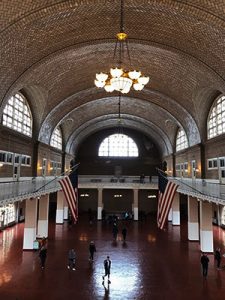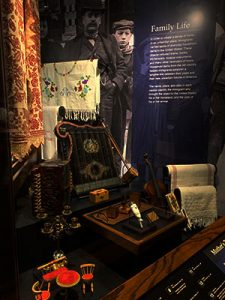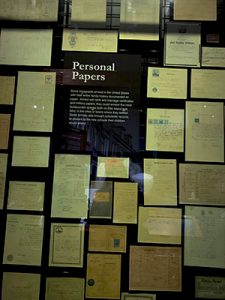
Ellis Island museum tells compelling story
NEW YORK— Jeff Dosik, a librarian at the Ellis Island National Museum of Immigration, sits at the front desk of his office on a rainy Thanksgiving Eve while pondering on the most educational exhibition currently featured at the attraction.
“I think ‘Treasures From Home’ is the most educational exhibition we have at the museum. It is filled with artifacts the immigrants brought with them to America, such as clothing, shoes, bedding, legal documents, children’s toys, and photographs of their homelands. These items give museum visitors a psychological look at the human minds of immigrants at the time,” stated Dosik.
 |
The main building, where millions of immigrants passed through at Ellis Island National Museum of Immigration (Photos by Claudia Safavi). |
In creating the museum, there needed to be artifacts for display. Exhibits such as “Treasures From Home” requires that the artifacts must be from the old country brought to America.
The National Park Service, which oversees the museum as part of the Ellis Island and Statue of Liberty National Monuments, announced it was looking for these donations.
“Donators had to undergo an intensive process to prove they were families of immigrants. We have to accept the claims from these families if they are reasonable. The park researches the family background and assesses historical records. Once this is proven, the thing we do not know for sure is if the artifact was present the day the immigrants arrived at Ellis Island. Experts then come in to consult. There is also a network of culture research sites around the world to help us prove this even further. We take photographs of the artifacts and then consult museums around the world to see if the styles are similar. We take on a logical process,” explained Barry Moreno, a Historian at the Ellis Island National Museum of Immigration.
Other significant exhibits within the museum consist of the Dormitory Room, Ellis Island Chronicles, and Silent Voices.
| Artifacts immigrants carried with them to the United States are on display in the “Treasures From Home” exhibit at the Ellis Island National Museum of Immigration. |  |
The Dormitory Room is where many immigrants, who were temporarily detained, stayed the night. Currently, it has been restored to its original appearance.
Also, on display is the Ellis Island Chronicles, which are five scale models showing the changes to Ellis Island throughout the years.
The Silent Voices exhibit shows the dilapidated buildings of 1954 after its abandonment before its restoration.
However, the main building is the ultimate staple of the museum.
The main building is where the Registry Room was located. It is where immigrants united all in one place and where officers interrogated them.
The main building of the museum leaves an emotional impact on guests as they enter through the baggage room, which is the space where immigrants once checked their luggage when they arrived off the ferry.
“I think the main building is truly magical to people visiting the historic site because this is where millions of immigrants landed. You get the feeling that you are standing in the same building that your great grandparents passed through, which sparks many emotions,” claimed Bob DeHaas, a visitor at the Ellis Island museum.
The museum even has an American Family Immigration History Center, where guests can search for their immigrant ancestors through passenger arrival records. Records can also be accessed online from any location by visiting LibertyEllisFoundation.org.
“I came to this museum based on the fact that it gives you a look at immigration history. I feel it is highly relevant to go here because immigration is an ongoing process, especially in today’s political climate”, voiced Ricardo Medina, a guest at the Ellis Island National Museum of Immigration. “I think the story of America has a lot to do with immigration. It is something we all have to embrace. Too often, politicians lose sight of what America stands for and reverse all the good that was done.”
A self-guided audio tour is available in 12 different languages, including American sign language and an audio descriptive version for the visually impaired.
 |
Original legal documents that immigrants brought with them to Ellis Island are on display. |
The Ellis Island National Museum of Immigration is a leading tourist attraction. As a result, it has a large social media presence.
“We have a social media team that posts content every day from history to current events. Our social media accounts encompass both the Statue of Liberty and Ellis Island. We are active on Facebook, Instagram, and Twitter, where we have a lively presence. It is our way of communicating to folks and keeping people engaged in our museum,” said Jerry Willis, the Public Affairs Officer for the Statue of Liberty National Monument. “Our social media team monitors visitor feedback. They are very engaged with users who provide feedback. People come from all over the world, and we have learned it is a trip of a lifetime. We get four and a half million visitors a year. The park management team is always looking to improve the visitor experience.”
People can follow the park on Instagram @statueellisnps, Twitter @statueellisnps, and Facebook @statuelibertynps.
If You Go
- Address: Statue of Liberty National Monument, New York, NY 10004.
- Phone: 832-960-0009.
- Hours: Monday- Saturday 8:30 a.m. to 5:30 p.m.; Sundays are open 24 hours.
- Parking: Visitors are required to take the ferry in order to get to Ellis Island. Ferries depart from both Battery Park, at the southern tip of Manhattan in New York City and at Liberty State Park in Jersey City, N.J.; the GPS address to get to the Battery Park ferry location is 1 Battery Place, New York, NY 10004; The most convenient place for visitors to park at Battery Park is on Battery Place, while private parking lots are also available; The GPS address to the Liberty State Park ferry dock is 1 Audrey Zapp Dr., Jersey City, NJ 07305; Parking is available at Liberty State Park for a fee; Parking spots at Liberty State Park are available for those with official placards.
- Public Transportation: Although there are parking options for both locations, visitors are encouraged to take public transportation to both ferry locations. See more details regarding subway lines and bus stops at https://www.nps.gov/elis/planyourvisit/publictransportation.htm.
- Ferry Transportation Admissions: Visitors are required to ride the ferry to get to Ellis Island; ferry fees are free for children under the age of 4; the ferry fee for children between the ages of 4 and 12 is $12; adults 13 and up must pay $18.50 for ferry access; seniors 62 years and older are charged $14; ferry tickets can be purchased by visiting https://www.statuecruises.com/; tickets can also be obtained by calling 1-877-LADY-TIX.
- Tours: 40-minute Ranger-Guided Tours are free and depart from the information desk on the hour; Audio Tours are free with the purchase of a ferry ticket; Hard Hat Tours of the Hospital Complex are guided 90-minute visits, which are $58.50 for adults and $53 for senior citizens (this also includes the price of the ferry); School Group Hard Hat Tours tickets are $25 per student and chaperon; the Hard Hat Tours are for ages 13 and older; all tickets can be purchased at the information desk at the Ellis Island National Museum of Immigration.

Comments are Closed